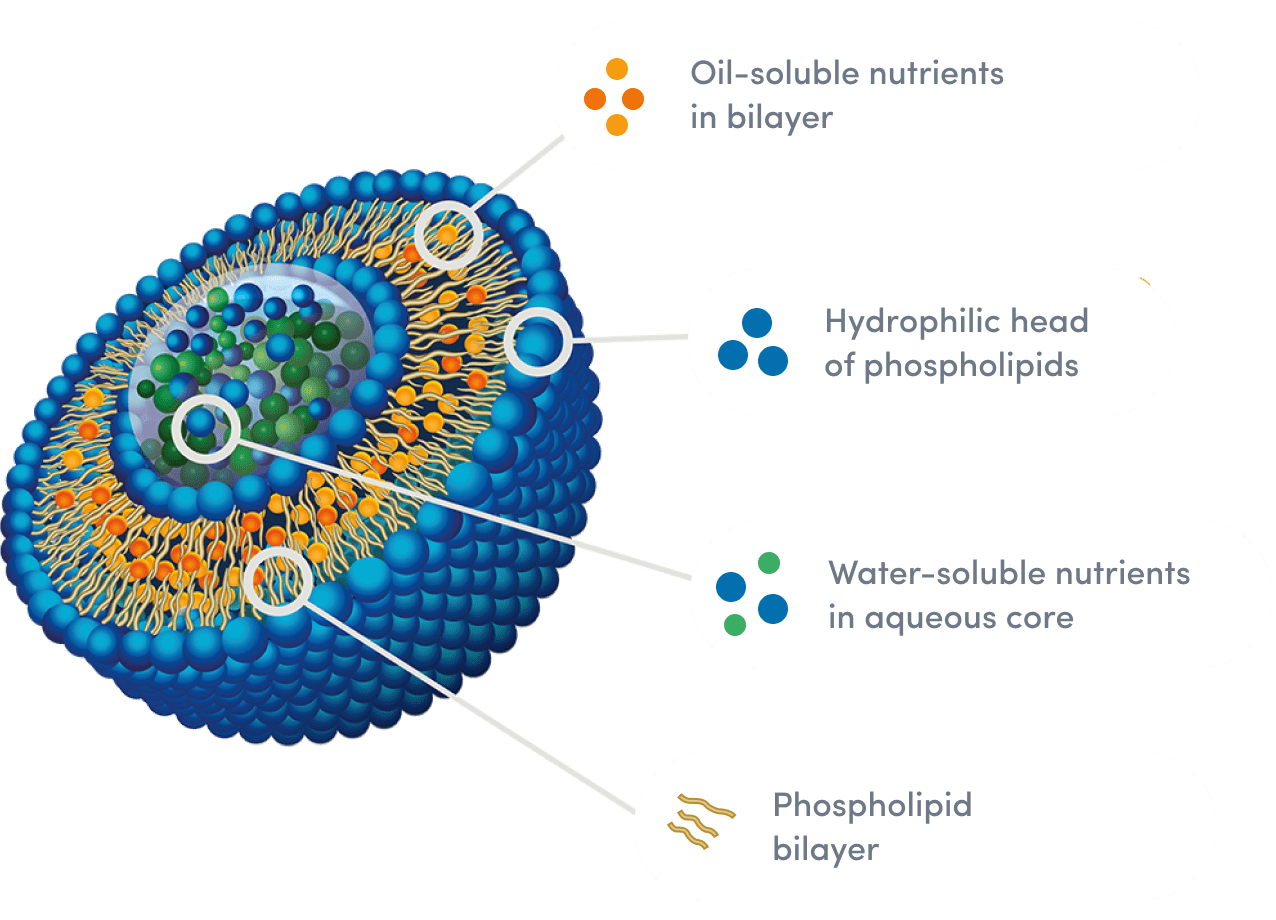Dwatro®Lip liposomal technology
Let's start
with the basics
Whether we are talking about a therapeutic substance (in medicines) or a nutritional substance (in dietary supplements), each must be given a pharmaceutical form in order to be administered to the body by the appropriate route, e.g. orally, parenterally or into the eye.
The pharmaceutical form, i.e. the carrier of the substance in question, is, for example, a tablet, capsule, syrup, eye drops, submicron emulsion and liposomes. Liposomal technology is an advance in the delivery of nutrients to the body, enabling more efficient absorption, i.e. absorption and utiliszation of nutrients.
What are
liposomes?

What is the phenomenon of liposomes and liposomal technology?
Liposomes, unlike other forms such as tablets or capsules, are made of phospholipids, the same components that make up the cells of the human body, which means that liposomes are biocompatible with our bodies, i.e. they are safe.
Liposomes, due to their unique structure, can cross biological barriers that usually limit the availability of delivered nutrients, thus significantly improving the effectiveness of dietary supplements.
Read more
Benefits of liposomal technology in dietary supplements.
Liposomes are made of the same components (phospholipids) as the cells of the human body, i.e. they are biocompatible.
This means that, with liposomes, we can deliver substances to our body's cells much more effectively (bioavailability is greater) than with other forms such as tablets or capsules.
For the oral route, it is very important that the liposomes are not as small as for the parenteral route, as they will be degraded in the gastrointestinal tract before they reach the correct site of action 4
Liposomes administered orally may even be multilayered so that the outer layer of the liposome can be digested in the gastrointestinal tract thus protecting the transported substance from degradation and safely delivering it to the site of the
absorption, i.e. into the intestines5.
Properly designed liposomes protect the transported substances from being broken down in the gastrointestinal tract, thus delivering the ingredients to the body's cells much more efficiently.
Show moreShow less
The correct structure of the liposome ensures much greater absorption of the transported substances, resulting in significantly more ingredients reaching the site of action.
It is reported in the literature that vitamin C administered in tablet form is absorbed in approximately 45%, while in liposomal form it is absorbed twice as much, i.e. from a tablet containing 1,000 mg of vitamin C approximately 450 mg reaches our cells, while from the liposomal form as much as approx. 900 mg.6
Liposomes not only protect the transported substance from being broken down in the gastrointestinal tract but also protect the gastrointestinal tract from the irritating effects of certain substances.
Liposomes administered orally, when passing through the gastrointestinal tract, are partially adsorbed in the gastrointestinal tract while being incorporated into its cells, which is an additional advantage of using products with liposomal technology.
Liposomes deliver substances directly to specific sites in the body
Due to their biocompatibility and similarity to natural cells, liposomes can cross biological barriers and deliver nutrients directly to where they are needed most2.
This unique property of liposomes allows for a significant increase in the effectiveness of the nutrients delivered.
This begs the question: why aren’t all substances produced and administered in the form of liposomes?
An additional problem is controlling the appropriate size of liposomes depending on the route of administration, which means that in the case of parenteral administration, we have to produce them in such a way that they are less than 1 µm in size so that blood vessel embolization does not occur.
For oral administration, on the other hand, liposomes should be larger, or even many times that size, so that the outer shell can be digested in the gastrointestinal tract and safely transport nutrients to the site of action.
Our Dwatro®Lip liposomal technology represents the future of nutrient delivery. Using the latest scientific research, our products provide increased bioavailability and efficiency. This allows nutrients to be transported through the body more efficiently, resulting in better utiliszation and more effective action. 3
Literature
(1) Kanásová M and Nesměrák K. Systematic review of liposomes’ characterization methods. Monatshefte fur Chemie (2017) 148: 1581–1593.
(2) Verma NK and Roshan A. Liposomes: A Targeted Drug Delivery System- A Review. Acta Medica Sci. (2015) 2: 65–70.
(3) Tiwari R, Ansari VA, Singh S, Khalid M, and Akhtar J. Liposomes: the novel approach in cosmaceuticals. World J. Pharm. Pharm. Sci. (2015) 4: 1616–1640.
(4) He H, Lu Y, Qi J, Zhu Q, Chen Z, and Wu W. Adapting liposomes for oral drug delivery. Acta Pharm. Sin. B (2018) 9: 36–48.
(5) Alavi M, Karimi N, and Safaei M. Application of various types of liposomes in drug delivery systems. Adv. Pharm. Bull. (2017) 7: 3–9.
(6) Łukawski M, Dałek P, Borowik T, Foryś A, Langner M, Witkiewicz W, et al. New oral liposomal vitamin C formulation: properties and bioavailability. J. Liposome Res. (2020) 30: 227–234.

